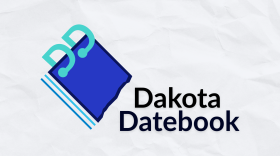
Sitting Bull to Phil Jackson, cattle to prairie dogs, knoephla to lefse. North Dakota's legacy includes many strange stories of eccentric towns, war heroes, and various colorful characters. Hear all about them on Dakota Datebook, your daily dose of North Dakota history.
—
Dakota Datebook is made in partnership with the State Historical Society of North Dakota, and funded by Humanities North Dakota, a nonprofit, independent state partner of the National Endowment for the Humanities. Any views, findings, conclusions, or recommendations expressed in the program do not necessarily reflect those of Humanities North Dakota or the National Endowment for the Humanities.
You can find all Dakota Datebooks from 2018-today below. Our archive of Datebooks from 2003-2017 can be found here.
-
In November of 1970, billboards began popping up along highways in Montana and South Dakota with bold letters stretching across the landscape: “Go North to Dakota!”
-
The Commercial Hotel, built before 1878, was among the first few buildings in Wahpeton, and its only hotel before the boomtown years. It was advertised as "first-class in every way," popular with those seeking business opportunities, land claims or a quick Dakota Territory divorce.
-
The 1910 polio epidemic began in the Northeast and spread across the country. It primarily affected children and caused widespread fear and confusion. There were no reliable treatments, and desperate parents sometimes turned to unproven methods to help their children.
-
November 19 marks the annual Lydia Pinkham Open Studios event in Lynn, Massachusetts, showcasing artists at the historic factory where Lydia’s famous Vegetable Compound for Women was manufactured.
-
On this date in 1932, a two-day demonstration of Boy Scout activities was held at the Wahpeton Indian School for troops from Richland and Wilkin counties. Physician and author Charles Alexander Eastman, a Sisseton-Wahpeton Dakota, served as an advisor in developing the national Boy Scout movement and its Native American Lore component.
-
North Dakota tops all other states in the production of several crops, including oats, flaxseed, canola, and peas, and ranks second in sunflowers and wheat. The state usually places between 15th and 20th in national corn production. While corn isn’t one of North Dakota’s top crops, it’s still significant, its annual production is valued at about two billion dollars.
-
I’m going to share with you a story you probably won’t believe, but it’s true. Long before Red Bull or Monster, a farmer in North Dakota may have stumbled on the first real “energy drink.”
-
In 2008, Woodrow Wilson Keeble was posthumously awarded the Congressional Medal of Honor by President George W. Bush for his actions in the Korean War.
-
Steamboats on the Missouri and Red Rivers once made travel much easier. Of course, the steamboats had to be taken out of the water for the winter but the rivers were still used for travel.
-
The measles cropped up in North Dakota in 1905. At first, it didn’t attract much attention, and there were only small mentions of it. Newspapers reported that “W.S. Dow has been wrestling with the measles this week,” and “H.M. Blazer and family are sick with the measles.” These small incidents were precursors to the main event.
Dakota Datebook is made in partnership with the State Historical Society of North Dakota, and funded by Humanities North Dakota, a nonprofit, independent state partner of the National Endowment for the Humanities.
Any views, findings, conclusions, or recommendations expressed in the program do not necessarily reflect those of Humanities North Dakota or the National Endowment for the Humanities.


